As we have indicated in many other articles on this site, getting PSA airtime is becoming more competitive every year as the media increases the amount of paid commercials they use, which leaves less time for PSAs. However, if you follow these guidelines when planning your next PSA campaign, you can greatly increase your chances of getting free exposure for your organization.
- What is Your Communications Plan?
As you begin thinking about your PSA program, which is different from distributing a PSA campaign, think seriously about what you are trying to accomplish? For example, who are your primary and secondary target audiences, and what media can most efficiently deliver them? While broadcast TV delivers the biggest audiences, it is also the most expensive in terms of production, and it does not allow you to target specific demographics. If you are trying to reach specific audiences, then perhaps radio or outdoor would be better media options to consider. Production costs for those media are much less expensive than TV and will allow you to target your message to more specific demographics. - Select An Ad Agency With Relevant Experience
When it comes to producing PSAs, all ad agencies or production facilities are not the same. Producing PSAs is definitely an art, and the rules on what you can and cannot do are completely different than commercial ad production. For example, you can’t promulgate controversial issues; you cannot be overly aggressive in fund raising appeals; and you need to provide the media with PSAs in different sizes and spot lengths because they will be used to fill unsold time and space. For these reasons, it is best to select an ad agency or producer with PSA experience because they know the rules and will avoid costly mistakes that may prevent you from getting your PSAs used. 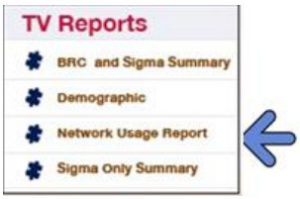 Cultivate the Networks.
Cultivate the Networks.
We typically distribute our client PSAs to about 200 national broadcast and cable TV networks, which can contribute a significant amount of the overall exposure you will get from your TV PSA campaign.How do we know this….because one of the online evaluation reports we provide to clients shows how much network support they have gotten, separate from all other exposure.For our clients we use our outreach specialist to contact each of the networks to pitch our client PSAs to them, which we believe has greatly increased our network exposure. For more information on how to approach the networks and their requirements, see the article “Network Clearance – A Producer’s Checklist.”- Know What Stations Will Use.
If your organization is involved with gun control, abortion, religious issues, or any other issue that is highly controversial, save your money. Do not distribute PSAs to the media – broadcast TV in particular – because they are not likely to be used. TV stations do not want to light up their switchboards by airing messages that are not consistent with local interests, or anything that is likely to stir up controversy. If you are in doubt about the popularity of your issue, then send TV stations a storyboard of the campaign you want to distribute, or do a survey before you spend a lot of money on distribution. Note: radio, cable TV and outdoor are much more flexible on this topic.  Know What Stations Can Use.
Know What Stations Can Use.
There are roughly 2,000 broadcast and cable TV stations in America today. In the new hi-definition world, send them what they can use, not what you can afford, and you’ll greatly increase the chances of getting air time. There are some other technical issues you need to know as well, and we have made this much easier for you by producing what we call a PSA Producer’s Guide, which you can view by clicking on the article below this one.- Promote Your Campaign to the Media.
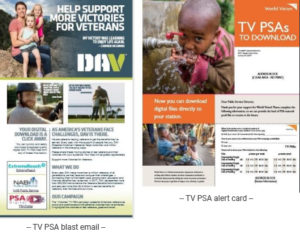 In the new world of digital distribution, if the media does not know how and where to download your PSAs, then obviously they cannot use them. We use a variety of promotional tactics to let them know where they can download our client PSAs, including direct mailings and blast emails, such as the examples shown here.
In the new world of digital distribution, if the media does not know how and where to download your PSAs, then obviously they cannot use them. We use a variety of promotional tactics to let them know where they can download our client PSAs, including direct mailings and blast emails, such as the examples shown here. - Use Digital Distribution.
It has been several years since we distributed PSAs via “hard copy” tapes and DVDs. The defacto standard is now digital distribution, and we use three different platforms to distribute our client PSAs to TV stations – our own site – which is called PSA Digital; Extreme Reach, the premier distribution site for video assets in the country; and the Spot Center site maintained by the National Association of Broadcasters.
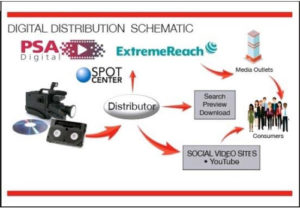
- Thank the Media for Their Support.
If you are the pubic service director for a TV station and you were responsible for getting your favorite non-profit organization’s PSA messages on the air, month after month, and year after year, but no one ever said “thank you,” how would you feel? Would it make you want to keep airing their messages?Media people are just like the rest of us; they want to feel appreciated when they donate their valuable media time and space on behalf of important social causes. When you go into any TV or radio station’s offices, you will see plaques and letters of appreciation on the walls of their office, because they want to be your partner in addressing important social problems. In a few words, when they help you get your message out, at least thank them for what they have done. You can send them letters signed by your organization’s senior officials; you can create inexpensive plaques they can hang on their walls; and you can visit them in your own community to express your appreciation. - Evaluate Your Campaign.
We can’t stress how important it is to know where and when your public service announcements are airing. It’s even nice to know what they are worth. Perhaps as important, you should know where they are not playing and why. If you don’t know, your boss will probably want to know: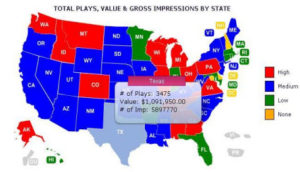
- What are we getting for our money?
- In which of our primary markets are we getting air time?
- What kinds of audiences are we reaching with our message?
- Where are we NOT getting results and why?
One of the reports we produce for clients is a U.S. map showing TV PSA airtime for four different levels of support as shown here.
- Consider “Contracting Out.”
Even after the challenging job of getting your campaign “in the can,” you’ve still got a lot of work to do. There are mailing lists to compile, collateral materials to create, coordinating digital distribution to stations, posting digital files to download sites, and other tasks. That’s just to get the campaign to the media; then there’s a separate evaluation effort to organize. You may be able to reduce costs and use your staff more productively by selecting a full-service vendor to handle these important but tedious details.




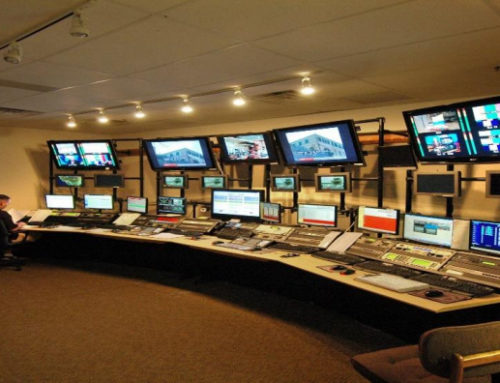

Leave A Comment